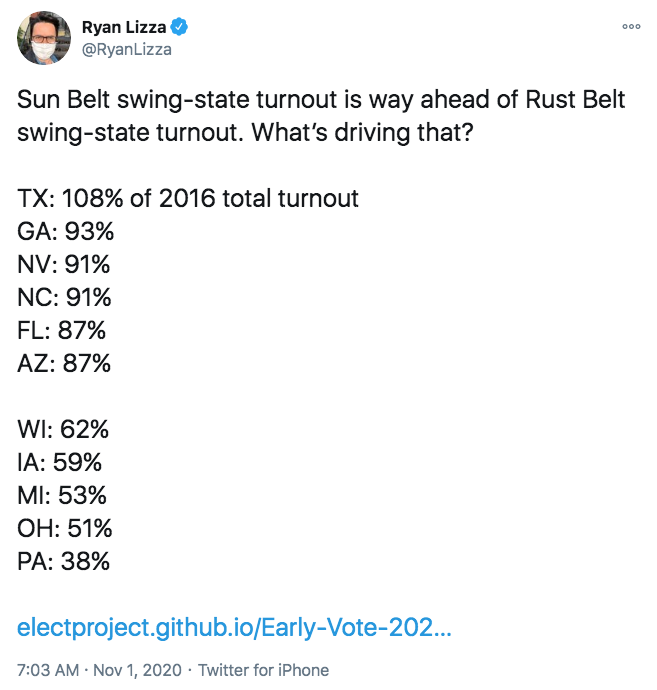This tweet caught my eye:

Texas has surpassed 2016 even if you account for population growth. (Many sunbelt states have seen 4% to 6% population growth since 2016.) In September, my Trump win prediction was based on three factors, each worth close to 3%; Electoral College bias, polls narrowing, and poll bias due to shy Trump voters. (Many Trumpistas are beta males, who are too timid to proudly state their beliefs in the way that you and I do.)
Obviously things are not looking good for my hypothesis. The polls actually got worse for Trump in October, before narrowing recently to about 8%. While the EC bias is still about 3%, Trump will need a 5% polling error to win. Even worse, many of the votes were cast when the polling margin was a bit higher.
Another problem for Trump is that we’re headed for a big turnout. That doesn’t necessarily favor the Dems, but it tends to. Hillary was clearly hurt by a low turnout of minority voters. For instance, Texas is typically a low turnout state. It’s hard for me to believe that Texas would still be strongly red if turnout were very high, given that only 41% of Texans are white non-Hispanic. (I emphasize “strongly”, as Texas Hispanics are less Democratic than in California.)
Another problem for Trump is that polls suggest that Dems are very enthusiastic about voting this year. And other problem is that polls show the Dems likely to do very well in House races, where the shy Trump voter bias is not much of an issue. So he has his work cut out for him in the next two days.
[And he’s being outspent, which seems impossible for a man who claims to be worth $10 billion. But . . . ]
Some people say “Don’t look at the national polls; look at the swing state polls. In my view, that’s only useful for ascertaining the EC bias. Once you’ve done that, the national polls are what you want to look at. Here’s why:
Let’s say the national polls are roughly correct, or at least within 3%. In that case Trump loses even if he wins Pennsylvania, and even though PA is the mostly like swing state. That’s because if the national polls are within 3%, then any extremely surprising result in one state (like PA) must be offset by a weaker Trump performance somewhere else (like Arizona or North Carolina.) If Biden wins the popular vote by 5%, he will win the election. If he wins by 4% he’ll probably win the election. If he wins by 3% then Trump will probably win the election.
Here’s another way to think about polling errors. Last time around, the national error was 2% and the polling error in midwestern swing states was 4% or more. But that means the polling error in places like Arizona was less than 2%. So unless the national polling error is really large, another big miss in the Midwest would imply that Biden is likely to win states like Arizona and North Carolina.
If we assume that Wisconsin and Michigan are out of reach, then Trump doesn’t need to just hold Pennsylvania; he needs to win all the states on the list above except Nevada.
[Technically speaking, Biden picking up WI, MI and AZ would yield a tie, but Biden’s also leading in Omaha. Believe it or not, Omaha might well be the “swing state” in an election where Trump wins PA and loses AZ. I only know one Omaha resident (Buffett) and I assume he’s voting for Biden.]
It’s probably pointless for me to predict the presidential election, given that I’ve lost touch with American politics. (I got them all correct from 1968-2012, before missing badly in 2016.) Instead I’ll just predict a very strong pro-Trump EC bias, even stronger than in 2016 (when it was about 2.9%.) Just to make things interesting, let’s say an EC bias of 3.5%. I base that prediction on the assumption that the Dems continue to gain ground in states that they would likely lose in a close election, such as Texas and Georgia. (They might win Georgia, but they’d lose it in a close election.)
Totally off topic, a week ago I forgot to link to this amusing NY magazine story about Jay Powell:
While Powell is a Republican, all three of these shifts are victories for the mostly left-leaning crew of Fed watchers who spent the past decade pushing the central bank to focus less on inflation and more on employment. This movement has included organized groups, like Fed Up, that exist to lobby the bank and make it more accountable to the public. It also includes academics and journalists who seemed a decade ago to be mostly a bunch of borderline cranks talking about nominal GDP targeting in op-eds and on Twitter. But you never know who you’ll reach on Twitter — and Powell, like Romney before him, has a secret Twitter account, and he pays attention to what is being said there.
The borderline crank comment probably doesn’t refer to me, as I’m definitely not “borderline”. Probably they were thinking of the more respectable member of the Mercatus team, David Beckworth. I’m an out and out crank, approaching MMT levels of weirdness.